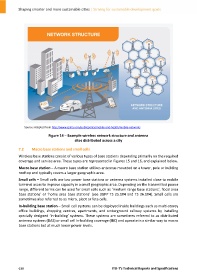Page 628 - Shaping smarter and more sustainable cities - Striving for sustainable development goals
P. 628
Source: Adapted from http://www.gsma.com/publicpolicy/mobile‐and‐health/mobile‐networks
Figure 14 – Example wireless network structure and antenna
sites distributed across a city
7.2 Macro base stations and small cells
Wireless base stations consist of various types of base stations depending primarily on the required
coverage and service area. These types are represented in Figures 15 and 16, and explained below.
Macro base station – A macro base station utilizes antennas mounted on a tower, pole or building
rooftop and typically covers a larger geographic area.
Small cells – Small cells are low power base stations or antenna systems installed close to mobile
terminal users to improve capacity in a small geographic area. Depending on the transmitted power
range, different terms can be used for small cells such as ‘medium range base stations’, ‘local area
base stations’ or ‘home area base stations’ (see 3GPP TS 25.104 and TS 36.104). Small cells are
sometimes also referred to as micro, picot or feta cells.
In‐building base station – Small cell systems can be deployed inside buildings such as multi‐storey
office buildings, shopping centres, apartments, and underground railway systems by installing
specially designed ‘in‐building’ systems. These systems are sometimes referred to as distributed
antenna systems (DAS) or small cell in‐building coverage (IBC) and operate in a similar way to macro
base stations but at much lower power levels.
618 ITU‐T's Technical Reports and Specifications

